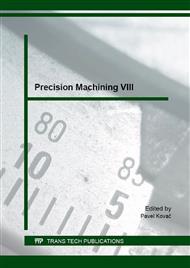[1]
C. Guo and S. Malkin, Thermal analysis of grinding, Annals of the CIRP, Vol 56/2007, pp.760-782.
DOI: 10.1016/j.cirp.2007.10.005
Google Scholar
[2]
M. Gostimirovic, M. Sekulic, J. Kopac and P. Kovac, Optimal control of workpiece thermal state in creep-feed grinding using inverse heat conduction analysis, Strojniški vestnik-Journal of Mechanical Engineering, Vol. 57/10/2011, pp.730-738.
DOI: 10.5545/sv-jme.2010.075
Google Scholar
[3]
M. Gostimirovic, P. Kovac, D. Jesic, B. Skoric and B. Savkovic, Surface layer properties of the workpiece material in high performance grinding, Metalurgija, Vol. 51/1/2012, pp.105-108.
Google Scholar
[4]
J.C. Jaeger, Moving sources of heat and temperature at sliding contacts, Proceeding of the Royal Society of New South Wales, Vol. 76/1942, pp.203-224.
DOI: 10.5962/p.360338
Google Scholar
[5]
W.B. Rowe, J.A. Pettit, A. Boyle and J.L. Moruzzi, Avoidance of thermal damage in grinding and prediction of the damage threshold, Annals of the CIRP, Vol. 37/1/1988, pp.327-330.
DOI: 10.1016/s0007-8506(07)61646-1
Google Scholar
[6]
A.S. Lavine, A simple model for convective cooling during the grinding process, ASME Journal of Engineering for Industry, Vol. 110/1988, pp.1-6.
DOI: 10.1115/1.3187837
Google Scholar
[7]
M.C. Shaw, A simplified approach to workpiece temperatures in fine grinding, Annals of the CIRP, Vol. 39/1/1990, pp.345-347.
DOI: 10.1016/s0007-8506(07)61069-5
Google Scholar
[8]
C. Guo and S. Malkin, Analytical and experimental investigation of burnout in creep-feed grinding, Annals of the CIRP, Vol. 43/1/1994, pp.283-286.
DOI: 10.1016/s0007-8506(07)62214-8
Google Scholar
[9]
Y.J. Zhan and X.P. Xu, An experimental investigation of temperatures and energy partition in grinding of cemented carbide with a brazed diamond wheel, International Journal of Advanced Manufacturing Technology, Vol. 61/2012, pp.117-125.
DOI: 10.1007/s00170-011-3706-7
Google Scholar
[10]
M. Gostimirovic, P. Kovac, M. Sekulic and B. Skoric, Influence of discharge energy on machining characteristics in EDM, Journal of Mechanical Science and Technology, Vol. 26/1/2012, pp.173-179.
DOI: 10.1007/s12206-011-0922-x
Google Scholar
[11]
M.J. Hadad, T. Tawakoli, M.H. Sadeghi and B. Sadeghi, Temperature and energy partition in minimum quantity lubrication-MQL grinding process, International Journal of Machine Tools & Manufacture, Vol. 54-55/2012, pp.10-17.
DOI: 10.1016/j.ijmachtools.2011.11.010
Google Scholar
[12]
M. Gostimirovic, P. Kovac and M. Sekulic, An inverse heat transfer problem for optimization of the thermal process in machining, Sadhana, Vol. 36/4/2011, p.489–504.
DOI: 10.1007/s12046-011-0034-4
Google Scholar
[13]
I. Mankova, M. Vrabel, J. Beno, P. Kovac and M. Gostimirovic, Application of taguchi method and surface response methodology to evaluate of mathematical models to chip deformation when drilling with coated and uncoated twist drills, Manufacturing Technology, Vol. 13/4/2013, pp.492-499.
DOI: 10.21062/ujep/x.2013/a/1213-2489/mt/13/4/492
Google Scholar
[14]
J. Kundrak and G. Varga, Use of Coolants and Lubricants in Hard Machining, Technical Gazette, Vol. 20/6/2013, pp.1081-1086.
Google Scholar
[15]
P. Kovac, M. Rodic, V. Pucovsky, B. Savkovic and M. Gostimirovic, Multi-output fuzzy inference system for modeling cutting temperature and tool life in face milling, Journal of Mechanical Science and Technology, Vol. 28/10/2014, pp.4247-4256.
DOI: 10.1007/s12206-014-0938-0
Google Scholar
[16]
M. Madić, M. Radovanović and M. Gostimirović, Ann modeling of kerf transfer in CO2 laser cutting and optimization of cutting parameters using Monte Carlo method, International Journal of Industrial Engineering Computations, Vol. 6/1/2015, pp.33-42.
DOI: 10.5267/j.ijiec.2014.9.003
Google Scholar


